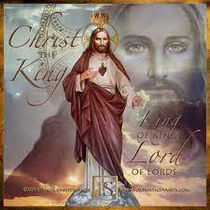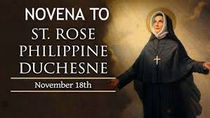The Catholic Defender: Father Isaac Jogues, St. John La Lande Martyrs
- Donald Hartley

- Oct 18, 2023
- 7 min read

Recently, I was able to participate at a Marian Conference held in Blue Springs Missouri and St. Joseph’s Radio recorded a talk I gave entitled, “Drums Among The Mohawks” which is about the true story of St. John La Lande.
For me this was a great joy as it was a kind of home coming. I was baptized at age 4 there in 1960, I began grade school there in 1963, and I received my first Confession and Holy Communion there in 1964. I was also received my Confirmation there on September 28th, 1968 by Bishop Sullivan.
I dedicated my talk to my Mother who had passed away August 2006 before I deployed to Iraq in October. My Mother sacrificed greatly sending her children toSt. John La Lande Catholic School in Blue Springs Missouri.
Drums among the Mohawks came to me as an idea because few people are aware of St. John La Lande. I assumed that St. John was related to the early Church, I never really knew much about him.
St. John La Lande was only 18 years old when he joined French Jesuit missionary, Father Isaac Jogues to go to the land of the Mohawks. As a young boy, St. John had been captivated by the heroine stories told of Father Jogues.

Father Jogues shared his tales and experiences of being a missionary among the Mohawks, bringing Christ and the gospel message to the people of the New World.
St. John’s enthusiasm to do God’s work was recognized by all who knew him, he spoke of the exploits of the missionaries who gave their lives as martyrs in Indian Territory and longed to go there.
Father Jogues originally arrived in North America for the first time in 1636 where he landed off the shore of Quebec. Father Jogues told his companion, Rene Goupil, “A century ago a Norman sea captain gave this place its name. He was on a ship here in the harbor, just as we are—only his ship was carrying the first white men to come up the Saint Lawrence River. When he saw the cliff there, the captain of that little ship was amazed. He cried out in his rough farmer’s French, ‘Que bec’ meaning ‘what a rock”.
The dangers among the Mohawks were well known. The Indians there were animist in their religious practice. They were polytheistic believing in many gods. Much of their rituals and ceremonies were superstitious.
The Sky-woman was to the Mohawk, their mother goddess who had fallen from the heavens through a hole in the sky.
The maple sapling and the flint were known as the “twin gods”, the maple represented the god of life and creator of humans, and the flint represented the god of death and destruction. These to the Mohawk were the birth of good and evil.

The Sky-holder was the teacher and the caretaker of the world.
The Thunders was called the “Hinon” who was the eldest brother of thunder and lightning.
Stonecoat was a giant believed to be hard as rock.
Flyinghead was a monster that appeared in the form of a giant disembodied head. This represented murder among the Mohawks.
Monster bear was a giant hairless bear that was connected to the creation of the big dipper in the night sky.
The Onyare, a dragon-like horned serpent that lived in the Great Lakes, feared for capsizing canoes and feeding on mankind.
The Tareya-wagon was the god who liberated the Mohawks from below the surface of the earth and led them to the Valley of the Mohawks on the surface of the earth.
The great peacemaker, a title given to Indian prophets like Hiawatha, these were the heroes of old among Mohawk legends.

To the Mohawk, religion was closely related to the natural world. There were rituals and ceremonials that were accompanied with the drums and dancing. Mohawk drums were typically filled with water giving them a unique percussion sound.
To the enemies of the Mohawk, they were a fierce people who specialized in torture and fighting. They instilled fear with the beating of the war drums heard coming from the mountains in the distance.
This was the reality and danger the missionaries encountered as they journey to reach out to the Mohawks with the gospel of Christ.
Father Jogues would be captured by the Mohawks in 1641 and was forced to run the “gauntlet” because the Iroquois blamed his chest of religious articles for causing a bad crop that year. The gauntlet was a form of Indian torture that few survived especially if the use of deadly weaponry were used.

The Indians would have their captives run between two lines of braves who might be armed with tomahawks, clubs, and knives. Sometimes clubs and sticks might be used for the fortunate ones. Well known settlers such as Daniel Boone, John Stark, and others ran the gauntlet.
Father Jogues wrote of his experience of running the gauntlet, “Before arriving at the Iroquois village we met the young men of the country, in a line armed with sticks… (Father Jogues and Companions were forced to walk slowly) for the sake of giving time to anyone who stuck us.”
Rene Goupil was not so fortunate as he would suffer martyrdom at the hands of the Mohawks. The Indians pulled out their hair and beards, Father Jogues right hand; his index finger (first digit) was literally burned while another finger was crushed by a warriors teeth.
Father Jogues would eventually be freed and returned home to France but he longed to return to the land of the Mohawks, all these stories were known by St. John La Lande who also wanted to go to the New World as a Missionary like Father Jogues. Finally, in 1646, St. John could hardly believe it that he would not only get the chance to go to Quebec, but to accompany Father Jogues on his second missionary journey.
To test the young 18 year old companion, Father Jogues asked St. John La Lande if he wanted to take this trip. Father Jogues personally didn’t believe he would survive this second time around. He warned St. John how others were permanently crippled and maimed even if they did survive. Father Jogues warned him, “If you have any fear, don’t come.”

None of this deterred St. John, his response was simply, “I’ll go with you”, so the mission was set.
On September 27, 1646, Father Jogues, John La Lande, and three Huron Indians set out from Quebec by canoe heading for the Mohawk village of Ossemenon. As they traveled, the Mohawk drums spoke through the canyons that they were on the warpath. Indian drums rang in the distance and two of the Huron Indian guides abandoned the missionaries fearing what was ahead of them.
Father Jogues and John La Lande would be captured; they were stripped, beaten, and taken to the village. In October 17, the Indians cut strips of flesh from Father Jogues neck and arms. Because of the Indian superstition, they blamed Father Jogues for an epidemic because of their religious items.

The Indians planned a mock feast inviting Father Jogues to attend one of the lodges where he was surrounded and attacked with tomahawks. He didn’t stand a chance. The Indians took the body of Father Jogues and paraded him throughout the village as a trophy. They ultimately decapitated the missionary priest.
St. John La Lande was separated from Father Jogues and placed in another lodge, when he learned of the Martyrs fate; St. John went out looking for the body only to suffer the same fate. St. John was martyred on 19 October, 1646.
Both Fr. Jogues and John La Lande were beatified by Pope Pius XI on June 21, 1925 and canonized on June 29, 1930. St. John La Lande’s feast day is October 19, the day he was martyred.
The stories of the brave Jesuit missionaries had a large impact in the North Eastern wilderness. I was watching an episode of Daniel Boone, staring Fess Parker, with my Father. In this episode, Israel Boone, Daniel Boone’s son, saved his father’s life that had been bitten by a rattle snake.

I became curious about the story line of Israel Boone and wondered if he was a fictitious character or if he was really Daniel Boone’s son. I found out that not only did Israel really exist; his story really touched my heart.
Israel Boone died at the battle of Blue Licks, Fayerre Co., Ky which was the last Shawnee Indian victory of the Revolutionary war.
The American’s were attacked by 350 Indians and their allies causing a retreat to flee down a hill, they were quickly surrounded fighting hand-to-hand with other Indians who had surrounded them.
Boone’s company was now surrounded and Boone ordered his men to retreat. He ordered his men to cross back over the river downstream while he continued to fight and cover his men.

Daniel was able to grab a running horse and ordered his 23-year-old son, Israel Boone, to retreat. but out of love, Israel disobeyed. “Father, I won’t leave you,” As Daniel turned to look for a horse for himself, Israel suddenly fell to the ground when a musket ball caught him in the neck. Boone realizing Israel was dead, mounted the horse and joined in the retreat. Daniel would say that Israel’s death was the hardest blow he ever felt.
What a joy it was to learn that Daniel’s father, Squire Boone was a convert to the Catholic Faith who had been a Quaker.
This means that Daniel Boone would have a Catholic background as well as family who were Quakers.
What a joy it is to find the Catholic Faith being spread about through those missionaries like Father Jogues and St. John La Lande to the Indians as well as the rank and file Catholics who bear witness every day to their homes and neighborhoods.





















Comments